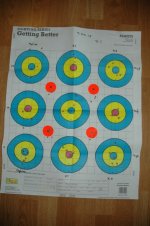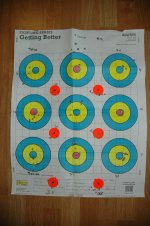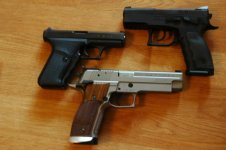rt11002003
New member
On Friday, 7-24, I took a SIG X-5, a HK P7 and a Sphinx Compact to the range. I practiced a technique called "bumping". The idea is squeeze the trigger to move the sear against the hammer, ease off, move the sear a bit more, ease off and repeat the cycle until the hammer falls. Done correctly, the shooter will never anticipate the hammer falling.
I fired the X-5, then the P7, followed by the Sphinx. That's lightest trigger pull to the heaviest pull.
I found the technique fairly easy to follow, at first. I'd get a little sloppy after awhile, then tighten up. Check the 10 yard target on the second sheet for the X-5. I think with practice, this technique will improve my shooting.
The gun hardest to use the technique on was the P7. I think it was because I was concentrating on the cocking handle and the trying to bump the sear at the same time. Kinda like walking and chewing gum.
Try "bumping" (if you haven't).
I fired the X-5, then the P7, followed by the Sphinx. That's lightest trigger pull to the heaviest pull.
I found the technique fairly easy to follow, at first. I'd get a little sloppy after awhile, then tighten up. Check the 10 yard target on the second sheet for the X-5. I think with practice, this technique will improve my shooting.
The gun hardest to use the technique on was the P7. I think it was because I was concentrating on the cocking handle and the trying to bump the sear at the same time. Kinda like walking and chewing gum.
Try "bumping" (if you haven't).



